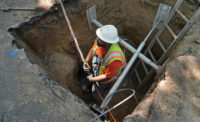The Federal Energy Regulatory Commission has given final approval to remove four dams on the Klamath River in Oregon and California in a Nov. 17 decision to allow surrender of the license to operate the facilities from a uitiity to a nonprofit removal firm, which will enable the history-making project to move forward.
With the action, the five FERC commissioners reaffirmed conclusions in the agency's final environmental impact statement – released Aug. 26 – concluding that the benefits of removing the four dams outweigh any adverse impacts, including those raised by opponents, and US Interior Dept approval earlier this year.
In the order, commissioners wrote that after weighing the environmental benefits and potential adverse effects, “We find that license surrender, decommissioning, and removal of the project developments are in the public interest.”
The FERC decision ends years of effort by stakeholders that include the Yurok tribe and others, the states of California and Oregon and the Klamath River Renewal Corp. (KRRC), the non-profit entity formed to oversee the removals and river restoration.
Supporters say the project will improve water quality and restore the ailing salmon population in the river. Opponents have argued that the removals would reduce the amount of water stored in reservoirs for wildfires, recreation and flood control.
The decommissioning process will begin once KKRC and the states review conditions of the license surrender and formally accept the transfer of ownership from PacifiCorp, KKRC’s CEO Mark Branson said the decision is a significant milestone in “the largest dam removal and river restoration effort in U.S. history.”
Under a progressive design-build contract signed in 2019 with the non-profit, Kiewit Infrastructure West was selected to remove the four dams. Early enabling construction will begin in the first quarter of 2023 and major dam removal will start in June 2024.
Early pre-drawdown work could begin as soon as March 2023. Early activities will include demolition of recreational areas, construction or roads and bridges, excavation of a low-level outlet tunnel through one of the dams. Draw-down of the reservoirs and dam removal are expected to begin in January of 2024, KKRC says. The project is expected to take 20 months, with five years of monitoring conditions like water quality and environmental restoration after the dams are removed.
Heavy civil firm Knight Piesold, which specializes globally in hydropower and mining services, is the engineering subcontractor. Texas-based Resource Environmental Solutions is the project’s restoration contractor.
The U.S. Army Corps of Engineers is still considering a Section 404 permit for the project under the Clean Water Act that would authorize placing about 212,000 cu yd of fill material within 20 acres of the Klamath River.
“As Yurok tribal people, it is our sacred duty to bring balance to the Klamath River,” Yurok Tribe Chair Joseph James said in a statement. “At its heart, dam removal is about healing and restoration for the river, for the salmon, and for our people. We have never wavered from this obligation and we are pleased to see dam removal come closer to reality."
Although the project had a wide range of support, environmental advocacy groups and others, including the National Hydropower Association, contend the current decommissioning process takes too long and does not incorporate enough input from tribes.
In a Nov. 17 blog post, Brian Graber, American Rivers’ senior director of river restoration noted that PacifCorp agreed in principle to transfer ownership of the dams in 2010. “It took 12 years after PacifiCorp agreed to remove the dams in principle, and 22 years after they first started the relicensing process, to finally determine the fate of the hydropower license and the dams,” he said.



_in_Conowingo_Station_Cecil_County_Maryland.jpg?height=200&t=1671739394&width=200)


Post a comment to this article
Report Abusive Comment